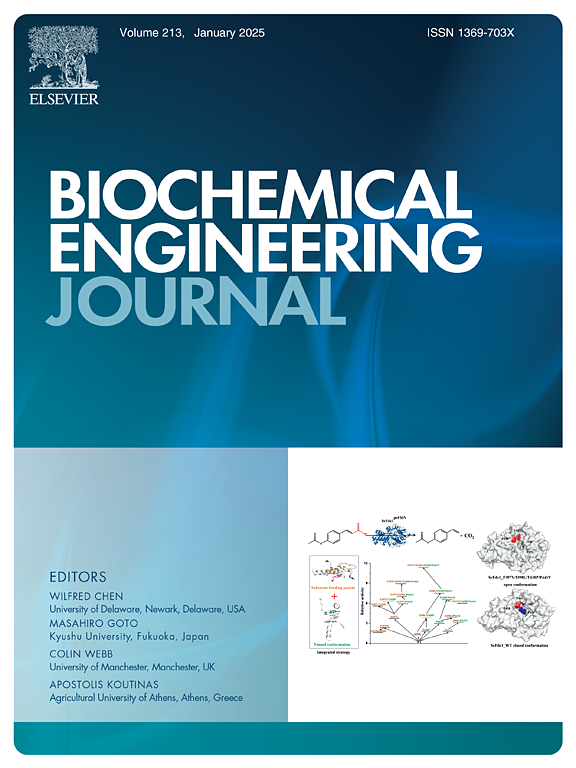Improving the fermentability of dilute acid hydrolysate and recovering low-concentration p-toluenesulfonic acid based on a fixed-bed column with hyper-cross-linked resin
IF 3.7
3区 生物学
Q2 BIOTECHNOLOGY & APPLIED MICROBIOLOGY
引用次数: 0
Abstract
As the closest pretreatment to industrialization, dilute acid hydrolysis is effective in producing fermentable sugars from lignocellulose. However, the reuse of acid catalysts is a difficult problem that restricts the economy of the biorefining process. In addition, inhibitors generated during dilute acid pretreatment seriously affect the bioconversion of fermentable sugars. In this study, the dynamic adsorption and desorption of dilute acid hydrolysate on a fixed-bed column with hyper-cross-linked resin were investigated to improve the fermentability of hydrolysate by removing inhibitors and recover the low-concentration p-toluenesulfonic acid (p-TsOH) for cyclic pretreatment. The results showed that p-TsOH can be recovered by dynamic adsorption and desorption for cyclic pretreatment, which released similar concentration of xylose compared with the first pretreatment. Moreover, the total sugar loss rate was less than 2 % after adsorption. The fermentability of hydrolysate after adsorption by the fixed-bed column was greatly improved. The fermentation performance of Trichosporon cutaneum (T. cutaneum) was enhanced with a yeast biomass of 19.26 g/L, lipid content of 25.62 %, and lipid yield of 4.93 g/L. Compared with the fermentation results of hydrolysate without detoxification, the lipid content and lipid yield increased by 67.12 % and 94.10 %, respectively. In summary, this study provides a feasible technology for improving the fermentability of dilute acid hydrolysate and recovering acid catalysts.
利用超交联树脂固定床柱提高稀酸水解物发酵性能,回收低浓度对甲苯磺酸
作为最接近工业化的预处理方法,稀酸水解是木质纤维素生产可发酵糖的有效方法。然而,酸性催化剂的再利用一直是制约生物精制工艺经济性的难题。此外,稀酸预处理过程中产生的抑制剂严重影响可发酵糖的生物转化。本研究采用超交联树脂在固定床柱上动态吸附和解吸稀酸水解产物,通过去除抑制剂提高水解产物的发酵性,回收低浓度对甲苯磺酸(p-TsOH)进行循环预处理。结果表明,通过动态吸附和解吸,循环预处理可回收p-TsOH,与第一次预处理释放的木糖浓度相近。吸附后的总糖损失率小于2 %。经固定床柱吸附后的水解液发酵性大大提高。酵母生物量为19.26 g/L,脂质含量为25.62 %,脂质产率为4.93 g/L,提高了皮毛霉的发酵性能。与未解毒的水解产物发酵结果相比,脂质含量和产率分别提高了67.12 %和94.10 %。综上所述,本研究为提高稀酸水解物的发酵性和回收酸催化剂提供了一种可行的技术。
本文章由计算机程序翻译,如有差异,请以英文原文为准。
求助全文
约1分钟内获得全文
求助全文
来源期刊

Biochemical Engineering Journal
工程技术-工程:化工
CiteScore
7.10
自引率
5.10%
发文量
380
审稿时长
34 days
期刊介绍:
The Biochemical Engineering Journal aims to promote progress in the crucial chemical engineering aspects of the development of biological processes associated with everything from raw materials preparation to product recovery relevant to industries as diverse as medical/healthcare, industrial biotechnology, and environmental biotechnology.
The Journal welcomes full length original research papers, short communications, and review papers* in the following research fields:
Biocatalysis (enzyme or microbial) and biotransformations, including immobilized biocatalyst preparation and kinetics
Biosensors and Biodevices including biofabrication and novel fuel cell development
Bioseparations including scale-up and protein refolding/renaturation
Environmental Bioengineering including bioconversion, bioremediation, and microbial fuel cells
Bioreactor Systems including characterization, optimization and scale-up
Bioresources and Biorefinery Engineering including biomass conversion, biofuels, bioenergy, and optimization
Industrial Biotechnology including specialty chemicals, platform chemicals and neutraceuticals
Biomaterials and Tissue Engineering including bioartificial organs, cell encapsulation, and controlled release
Cell Culture Engineering (plant, animal or insect cells) including viral vectors, monoclonal antibodies, recombinant proteins, vaccines, and secondary metabolites
Cell Therapies and Stem Cells including pluripotent, mesenchymal and hematopoietic stem cells; immunotherapies; tissue-specific differentiation; and cryopreservation
Metabolic Engineering, Systems and Synthetic Biology including OMICS, bioinformatics, in silico biology, and metabolic flux analysis
Protein Engineering including enzyme engineering and directed evolution.
 求助内容:
求助内容: 应助结果提醒方式:
应助结果提醒方式:


